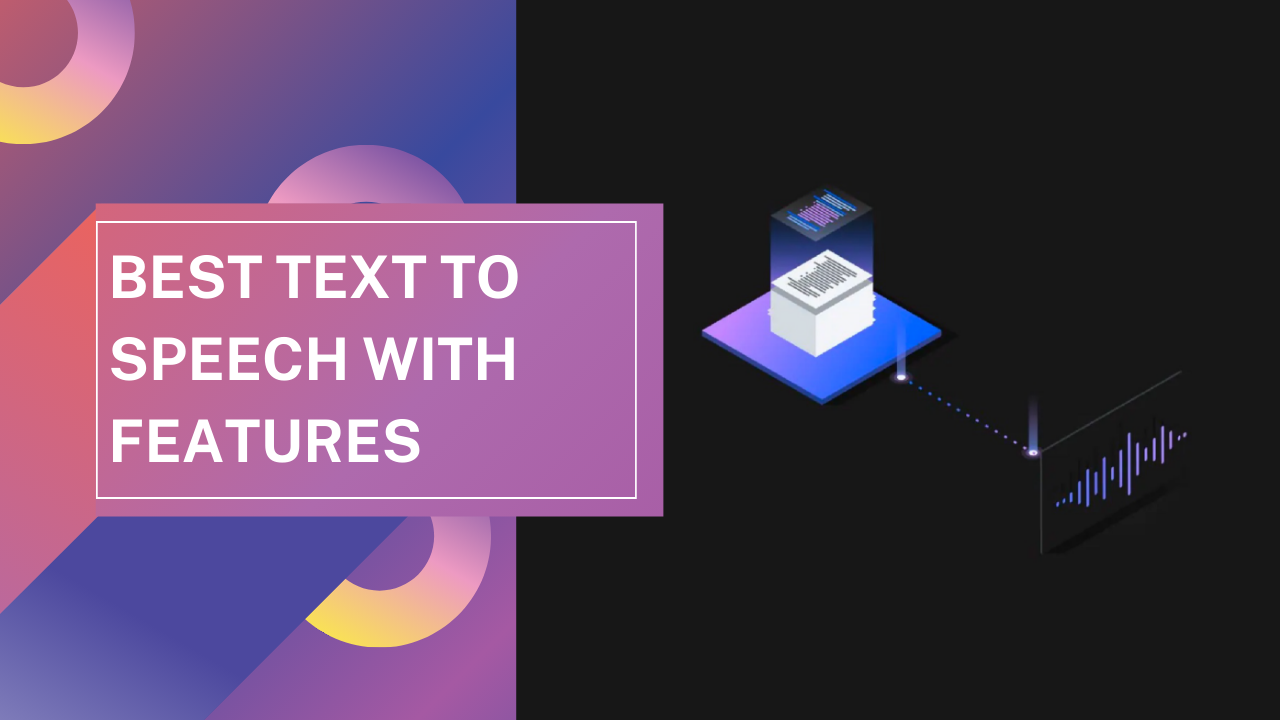Text to Speech (TTS) technology allows computers to read written text as spoken words. This amazing tool helps many people, like those who have trouble reading or prefer listening.
In this article, we will discuss the top 5 best Text to Speech tools and their unique features. We’ll explore how each one stands out, making it easier for you to choose the right one for your needs.
Top 5 Best Text to Speech Features
1. TextoSpeech
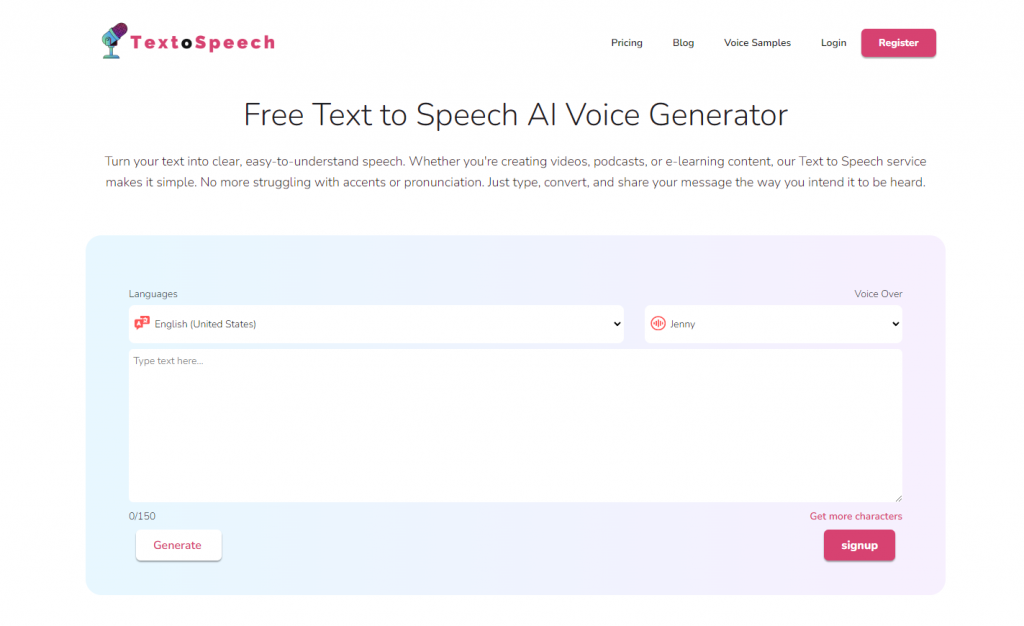
TextoSpeech is a text-to-speech tool that turns written text into spoken words. It’s designed for creating various types of audio content like videos, podcasts, audiobooks, and e-learning materials.
This service offers a wide range of voices in different accents and languages, and it allows users to adjust speech speed, emphasize certain words, and add emotions to the audio. It’s user-friendly, requires no installations, and is suitable for beginners.
TextoSpeech also claims to provide natural-sounding voices, making it a useful tool for those looking to produce professional-quality voiceovers without the need for actual voice actors.
Features of TextoSpeech
- Supports over 50 languages and 300 voices, providing a diverse range of content needs.
- Provides an easy-to-use text editor with real-time preview for fine-tuning voiceovers.
- Flexible pricing plans, including a free version, low-cost subscription options for advanced features, and a lifetime plan.
- Natural-sounding voices that are ideal for YouTube videos and multimedia projects.
- Web-based platform, ensuring accessibility and convenience without the need for software installation.
- Fast processing speeds allow for faster turnaround on voiceover projects, increasing productivity.
Pros and cons of TextoSpeech
Pros
- Variety of Voices and Languages
- Ease of Use
- Time-Saving
- Cost-Effective
- Consistency
- Accessibility
Cons
- Limited Features in Free Version
- Lack of offline functionality
2. Murf AI
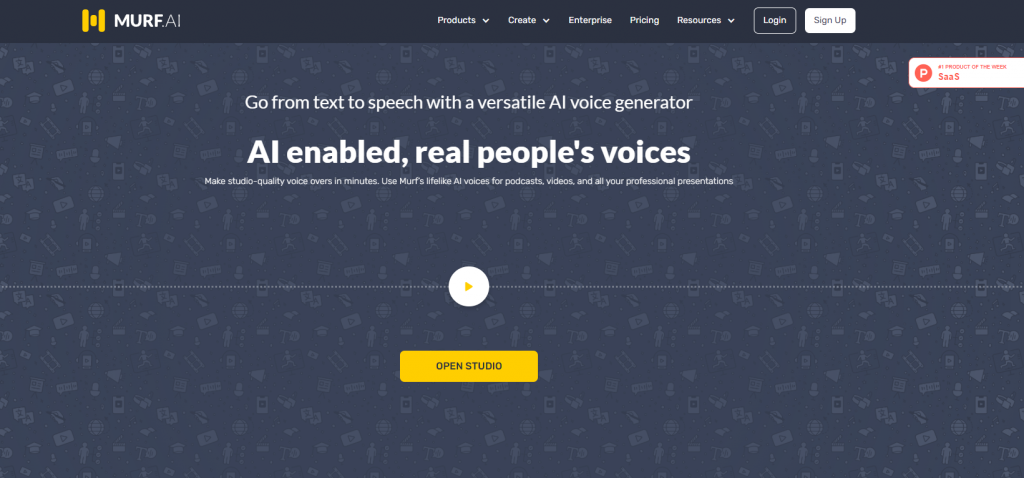
Murf AI is a versatile text-to-speech software that offers a range of features to enhance voiceover quality. Its AI technology can generate realistic human-like voices from text, making it useful for various applications like e-learning, advertisements, and podcasts.
Users can choose from a wide selection of voices in over 20 languages, customizing pitch, tone, and emphasis to suit their needs. Additionally, Murf AI allows for easy integration with videos and presentations, providing a user-friendly interface that simplifies voiceover production.
It’s an effective tool for creators seeking quick and professional voice solutions without needing extensive technical knowledge or resources.
Features
- Murf AI offers over 120 voices across 20 different languages, catering to a global user base.
- Includes voice cloning, AI dubbing, and integration with Canva for enhanced voice-over capabilities.
- Advanced text-to-speech editor, voice modulation options, and real-time voice editing for precise control.
- Flexible pricing plans, including a free trial, basic, pro, and enterprise levels, to suit different user needs.
- High-quality, lifelike AI voices are ideal for professional and personal projects.
- User-friendly interface, making it accessible for beginners and experts alike.
- Extensive library of AI voices, including options for different ages, accents, and styles.
Pros and cons
Pros
- Wide variety of voices
- Extra Effects
- Google Slides Add-on
- Performance
- Scalability
Cons
- Cost
- Learning Curve
- Reliability
- Customization
3. Speechify
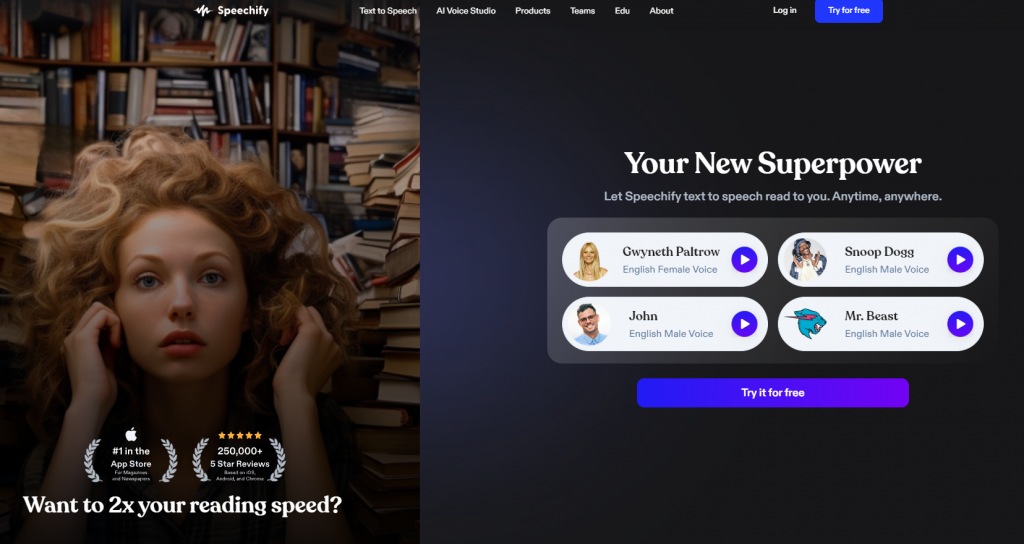
Speechify offers a range of text-to-speech features, enhancing the way users interact with written content. It converts various forms of text – like documents, articles, and emails into spoken words.
This technology is especially helpful for people who prefer auditory learning or have difficulties reading. Speechify’s AI voices are designed to sound natural, making the listening experience more enjoyable and understandable.
The service is accessible across different platforms, including browsers and mobile devices, allowing users to listen to content anywhere. This flexibility is particularly beneficial for multitasking, as it enables users to consume information while engaged in other activities.
Features
- Speechify offers over 30 languages and a wide range of 130+ voices, including natural-sounding and celebrity-like options.
- Includes reading speed control, highlighting text as it’s read, and converting text from books, PDFs, and web pages.
- Integrates with browsers and mobile devices, allowing seamless text-to-speech conversion across different platforms.
- Offers a free version with basic features and a premium plan with advanced capabilities like more voices and offline listening.
- High-quality voice synthesis, providing clear and natural-sounding audio for various content types.
- User-friendly interface, making it easy for users of all skill levels to navigate and use the tool effectively.
- Multi-device compatibility, supporting usage across computers, smartphones, and tablets for consistent accessibility.
Pros and cons
Pros
- Accessibility
- Language Learning
- Productivity
- OCR technology
- Support for Multiple Platforms
Cons
- Naturalness of Voice
- Accuracy and Pronunciation
- Subscription Costs
- Limited Context Understanding
4. Elevellabs
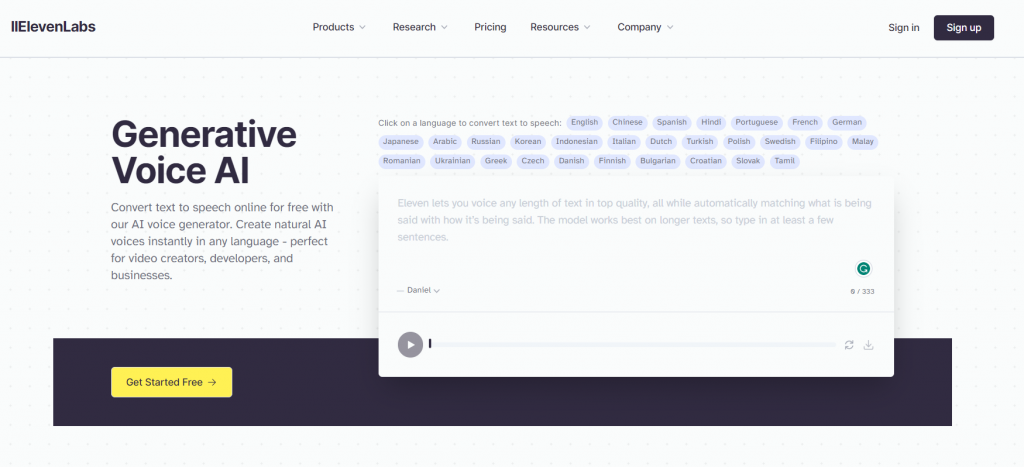
ElevenLabs offers a text-to-speech service with advanced AI voice generation capabilities. Their technology allows for the creation of lifelike, natural-sounding voices in a variety of languages and styles.
This service is suitable for various applications, such as content creation, gaming, audiobooks, and AI chatbots. ElevenLabs uses deep learning models to ensure the voices have human-like intonations and emotions.
Their platform is user-friendly, offering an intuitive interface for voice adjustment and customization. This makes it an ideal tool for individuals and businesses looking to enhance their digital content with high-quality spoken audio.
Features
- Generates high-quality audio from text using AI algorithms.
- Offers pre-designed voice profiles and the ability to create new voices from audio snippets
- For long-form content creation, such as audiobooks, with contextually-aware voices.
- Translates and preserves original voice characteristics in over 20 languages.
- Utilized by publishers and authors for AI-narrated content.
- Sets rules against misuse, supporting artistic and political speech
Pros and cons
Pros
- Human-Sounding Voices
- Versatile and Realistic AI Speech
- Voice Lab Feature
- High-Quality Audio
- Voice Library
- Intuitive Interface
Cons
- Control over the final aspects
- Huge number of features
- High Learning Curve
5. Narakeet
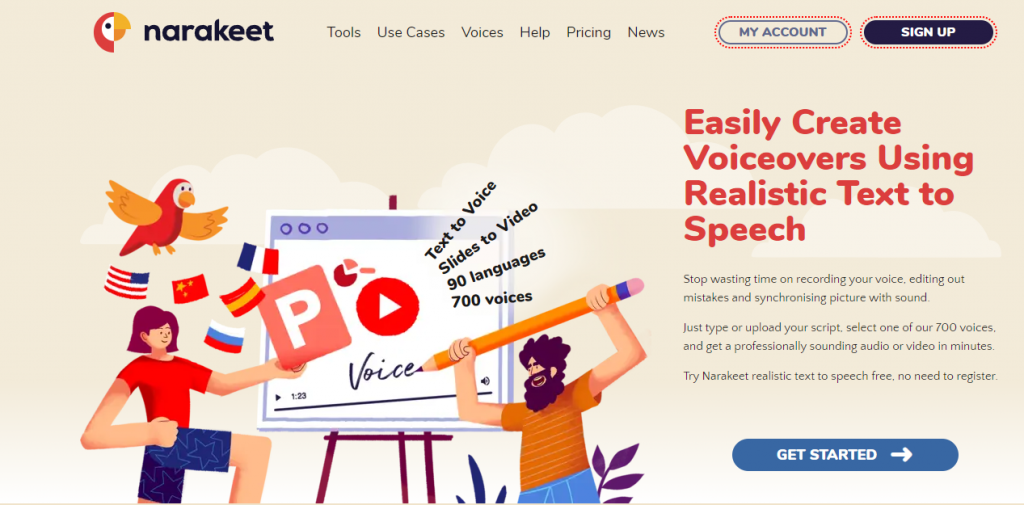
Narakeet is a platform specializing in text-to-speech features. It stands out for its ability to easily create realistic voiceovers and narrated videos. The service offers a diverse range of over 700 voices across 90 languages.
This versatility makes it ideal for various applications, including creating audio files, e-learning content, marketing videos, and even YouTube narrations. One of its key advantages is the time-saving aspect. Users can avoid the lengthy process of recording, editing, and synchronizing audio with video.
Instead, they can simply input or upload their script and quickly generate professional-quality audio or video files. Narakeet’s user-friendly interface and efficient processing make it a valuable tool for a wide range of users, from educators to marketers.
Features
- Offers over 700 voices across 90 languages, catering to a global audience and diverse content needs.
- Includes background music options, sound effects, and the ability to adjust speech speed and pitch for customized voiceovers.
- Easy-to-use script editor and the ability to convert PowerPoint presentations directly into narrated videos.
- Flexible pricing plans, including pay-as-you-go and subscription options, are suitable for various user needs and budgets.
- High-quality, natural-sounding voices enhance the overall audio experience of your content.
- Easily integrates with various content creation workflows, streamlining the process of adding voiceovers to videos and presentations.
- Wide accessibility with support for multiple languages and dialects, making it ideal for creating content for international audiences.
Pros and Cons
Pros
- Variety of Voices and Languages
- Ease of Use
- Time-Saving
- Cost-Effective
- Consistency
- Accessibility
Cons
- Limited Features in Free Version
- Lack of offline functionality
FAQs
What are the key features to look for in the best Text-to-Speech software?
The best TTS software should offer a wide range of natural-sounding voices, support for multiple languages, customizable speech speed and tone, the ability to understand the context for proper pronunciation, and an easy-to-use interface. Integration capabilities with other applications and platforms are also important.
Can Text-to-Speech software accurately mimic human emotion and intonation?
Advanced TTS software can mimic human emotion and intonation to a certain extent. They use AI and natural language processing to interpret text for appropriate emotional cues, though they may not be perfect in capturing the full range of human expressiveness.
Is there TTS software that can handle multiple languages and accents?
Yes, many top-tier TTS programs offer support for multiple languages and accents. They can read text in various languages with corresponding accent nuances, making them useful for global applications and multilingual users.
How accessible is Text-to-Speech software for users with disabilities?
TTS software is generally highly accessible for users with disabilities, especially for those with visual impairments or reading difficulties like dyslexia. Many TTS tools offer customizable features such as adjustable speaking rates and voice types to cater to individual needs.
Conclusion
Text-to-speech technology has evolved greatly, making information more accessible to everyone. It helps people with reading difficulties, enhances learning, and offers convenience in consuming content.
TextoSpeech TTS stands out with its user-friendly interface and diverse language options. Its clear and natural-sounding voices improve the listening experience, demonstrating the tool’s commitment to quality and inclusivity. This advancement marks a significant step in digital accessibility, benefiting a wide range of users.

